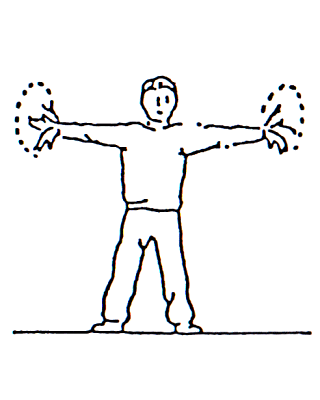(通手經絡及手神經腺)
顧名思義,這是一項將手掌反覆而有規律的掌部運動。
- 身體挺直,雙腳略為分開成八字形,左手和右手向橫伸直,這時雙手的掌心向地,十隻手指伸直,開始用雙掌一齊轉動,掌心一齊向下翻動復原向上,口叫「一」,轉動一下叫一數目,轉至十下為止。轉動手掌時十指要盡量伸直,這是一種掌骨和手掌的肌肉和血管運動。這是反掌運動的第一部分。
- 雙手仍向左右伸直,十指亦伸直,但掌心向天,掌背向地,用同樣的方法將雙掌同時翻動,翻動一下叫「一」,二下叫「二」,至十為止。然後雙手垂下至兩腿旁邊,這一式即告完成。
這兩部分看來似乎運動方法相同,實際上兩部分掌的翻動是不同方向的。由於第一部分雙掌心向下,翻動時掌是向前翻的,第二部分因雙掌掌心向天掌背向地,翻動時是掌向後轉的。因此是掌部的平衡運動,使手部的筋骨和末梢神經得到適當的伸縮運動,令手部的各穴位得到適量的伸張和收縮,其中合谷穴,寸關尺脈均可因運動而舒暢,經脈均能流通。
在中外各種健身運動中均無類似的運動方式,故可說是何瓊師傅所始創。其中雙臂伸開,在《易筋經》中的「韋馱獻杵」起首式也是這樣的,但無翻掌的運動。華陀《五禽獸》中的「馬戲」,雙掌向左右分開,但卻提起一隻腳,是以也不是「反掌」式。在現代物理治療中,治療師幫助因運動創傷掌骨的病人,在拆石膏後也幫助他慢慢翻掌。這一式也可作物理治療病人的自行鍛煉法。

Posture 5: Turn Over One’s Hand
The fifth posture, known as “Turn Over One’s Hand” is easy to learn. Just as the name suggested, it is the regular movement of both hands.
Movement 1: Stand upright, feet apart at shoulder width. Raise the arms slowly from the sides until they reach a horizontal position with the palms facing downward and keep the elbows and fingers straight. When start, turn the wrists in an anti-clockwise direction and count “one”. Repeat the same movement for ten times. This is an exercise for the bones of the wrist and the muscle and vessels of the palms.
Movement 2: The second part is the continuation of the first part. The hands are still stretching at a horizontal position with the fingers kept straight. This time, the palms are facing upward. Repeat the same movement as mentioned in movement 1. This time, turn the wrist in a clockwise direction. When turn once, count “one” and repeat for ten times. When finished, bring the hands down slowly.
The two movements of Posture 5 resembles each other but in fact the turning of both hands are in different direction. This alternate turnings in clockwise and anti-clockwise directions give the joints of the hands and the nerve endings some stretching, thus this exercise is well-balanced. This even gives some exercises to the acupoints of the hands especially the Hu Gu acupoint (合谷穴) and the Cun Guan Chi Mai (寸關尺脈). It facilitates blood circulation. The movement of raising both posture of Wei Duo Xian Chu (韋馱獻杵), the initial posture of “Yi Jin Jing” (Muscle Stengthening Exercise, 易筋經) But there is no turning of the hands. The same posture can also be found in the “Ma Xi” (Horse Play, 馬戲) of “Wu Qin Xi” (five Birds’ Play, 五禽戲) founded by Hua Tuo (華陀). But in the “Horse Play”, the two hands are raising up until they reach the horizontal position. But there is no turning over of the hands.
